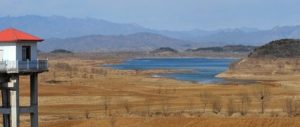Water diversion is back in the news in China thanks to the announcement of the 20-billion yuan (US$3.2 billion) Qiandao Lake project in Hangzhou, which has sparked controversy. Due to break ground during the next five years – the 12th Five Year Plan (FYP) period – the scheme aims to bring water from Qiandao Lake in Chun’an county to Xianlin, closer to downtown Hangzhou, the capital of eastern China’s Zhejiang province. Projects like this are not rare in China, but as Hangzhou is renowned for its rivers, lakes and beauty, this story has attracted particular attention.
Three decades of economic reform have set in motion in China an unprecedented urbanisation and industrialisation process, which has brought with it numerous large-scale water-transfer projects. Such schemes, which can easily cost 10 billion yuan (and often cost more), have helped create the conditions for rapid GDP growth. But the negative effects of these intensive and large-scale engineering projects have meanwhile been ignored. China still has a raging thirst for water-transfer, and even bigger plans are in the works.
There are good reasons for the Qiandao Lake project. Hangzhou relies on just one water source – the Qiantang River – for 80% of its drinking water. Industrial pollution along that river has worsened in recent years, and a serious incident could threaten the safety of drinking water for eight million Hangzhou residents. Both Zhejiang and neighbouring Jiangsu province have already built numerous large-scale water transfer projects, mostly designed to supply water to their large and medium-sized cities.
South China’s Pearl River Delta sees more rain than the rest of the country, but here too water diversion schemes are under way. Guangdong province is set to invest 23.6 billion yuan (US$3.7 billion) in a “West-to-East Water Transfer Project” during the 12th Five-Year Plan, benefitting 19 million residents in the cities of Guangzhou, Donghuang and Shenzhen.
The city of Kunming, on the shores of Dianchi Lake, in the south-western province of Yunnan, is also joining in. Here, a “Central Yunnan Water Transfer Project” – which aims to move 3.4 billion cubic metres of water a year along a 900-kilometre canal, at a total cost of 62.9 billion yuan (US$10 billion) – has been in planning for almost a decade. While Yunnan has plenty of water overall, supplies are not evenly distributed and planners say the centre of the province needs more.
In the north of the country, there have been several rounds of water-transfer construction over the decades. Rough calculations by New Century Weekly found that several dozen more at least are currently either under construction or in preparatory stages.
What has turned China into the world’s chief diverter of water in just a few decades? Cheng Xiaotao is deputy chief engineer at the China Institute of Water Resources and Hydropower Research. He believes that rapid urbanisation and industrialisation are the cause: “China’s population has increased by 700 or 800 million in the past few decades, and people have also been flowing into the cities with unprecedented speed. Urban industry is also rapidly expanding. This is something no other country has experienced. The water those people need just isn’t available locally.”
Under these conditions, some of China’s cities – particularly in the arid north – find themselves short of water, and a process begins: first, they appropriate water from agriculture; then they extract excessive quantities of groundwater; and, finally, water-transfer projects start.
Beijing was the first city to come up against water scarcity after the founding of the People’s Republic of China in 1949. To allow expansion of population and industry, in 1951 Beijing constructed the Guanting Reservoir on the Yongding River and, seven years later, it built the Miyun Reservoir on the Chaobai River. Nonetheless, a water shortage quickly became apparent. To meet the shortfall, the city started to pump groundwater. But, today, groundwater levels are several dozen metres lower than they used to be, and so the city is planning to bring water in from the Yellow River.
Tianjin, another enormous city in the north, has had similar experiences. In 1983, a landmark project was built to bring water to the city from the Luan River. This was followed by a scheme to divert water from the Yellow River in nearby Shandong.
And, as Beijng and Tianjin in the Hai River basin have reached out to the Yellow River, areas along the Yellow River itself have followed suit. In Qinghai, at the river’s source, a project to transfer water between two Yellow River tributaries, the Da and the Huang, is under way. Projects, both large and small, designed to extract water from the Yellow River are in motion in Inner Mongolia and the provinces of Shanxi, Shaanxi, Henan, Hebei and Shandong.
This has all placed an unbearable burden on the Yellow River. Recognising this, the Chinese government is turning to the Yangtze. One academic, who preferred not to be named, said that over the last decade, the idea of using water from the Yangtze to assist the Yellow River has become an accepted strategy among hydrologists.
These projects tend to cost somewhere between a billion yuan and tens of billions of yuan. Sometimes the price-tag is even higher: the mega South-North Water Transfer Project, which aims to divert water to the country’s parched north, is expected ultimately to cost hundreds of billions of yuan. One hydrologist said: “Many of China’s water transfer projects are carried out without regard to the costs.”
This makes sense: as the costs of a project are borne by central or provincial government, if a city can get a project approved, it has no immediate incentive not to push ahead. Clearly, this is one of the reasons behind the rising number of projects. But “free” water, with no water resource fee or environmental compensation costs built in, often becomes too expensive for cities and residents on the receiving end of the diversion canals.
In October 2003, the floodgates opened on a 10.3 billion yuan (US$1.6 billion), 10-year project, the first phase of a water-transfer channel from the Yellow River to the Jin River at Wanjiazhai in Shanxi, a province in north China. At the time, the city of Taiyuan planned to transfer 320 million cubic metres of water a year, while the Huyan Water Treatment Plant was built with a designed capacity of 800,000 cubic metres per day. Today the plant provides just 240,000 cubic metres a day.
Municipal water officials told Xinhua reporters that water has to be pumped uphill a number of times to reach Taiyuan – at a cost of five yuan per cubic metre. By the time the water has been treated and delivered to residents’ taps, the cost has climbed to eight yuan per cubic metre, far in excess of the price paid by those residents of less than three yuan per cubic metre. Water from the Yellow River has become too expensive, and the companies running the project in Taiyuan are selling it at a loss.
By the end of 2008, the Yellow River Water Supply Company had accumulated losses of 127 million yuan (US$20 million). Further losses of 90 million yuan (US$14 million) were seen in 2009. Large quantities of water pumped in from the Yellow River are simply dumped into Taiyuan’s waterways – treating it would only increase losses.
These problems are not confined to Taiyuan. With the completion of the second phase of that same project, identical issues are emerging in Shuozhou and Datong in the north of Shanxi. The same is true in Inner Mongolia and Shandong province, where water from the Yellow River is being moved to Hohhot and Qingdao respectively.
Decades of intensive water transfer have imposed a heavy price on the environment. Environmentalists commonly say that severe damage will be done to a river if 30% of its natural flow is syphoned off for other uses. By this standard, the Yongding, Chaobai and Luan rivers in the Hai River basin have already been used up – the waterways beyond the reservoirs are either dry or polluted, and there is no ecosystem to speak of.
The removal of water from the Yellow River for irrigation or to supply cities has meant that, in the last 10 years, only 20 billion cubic metres of water has actually reached the sea, down from 50 billion cubic meters in the 1950s. This sustained fall has left the nitrogen-phosphorus ratio in the Bohai Sea far out of balance. The Bohai used to be a rich fishery, but now there are hardly any catches and large numbers of marine organisms have disappeared.
Many academics also point out that the South-North Water Transfer Project may result in more salt-tides at the mouth of the Yangtze River, creating a crisis for Shanghai’s water supply. Shanghai obviously agrees – it is building a new reservoir at Qingcaosha to prevent saltwater intrusion.
Zhu Chun, freshwater projects officer at WWF China, believes that a genuine solution to water supply and demand problem must include better protection of local water sources. Long-distance water diversion schemes change the flow of rivers, affecting biodiversity, links between river basins and the hydrological cycle.
But many local governments regard water transfer as a cure-all, one hydrologist told us: if there’s a water shortage, they don’t try saving water, they just bring more in. If water is polluted, they don’t deal with the pollution, they just bring in new water. “It becomes the cure to all ills, and once you have the extra water you can continue with extensive economic expansion.”
Gong Jing and Cui Zheng are reporters at Caixin’s New Century Weekly, where this article was first published.
Homepage image by mjxian


